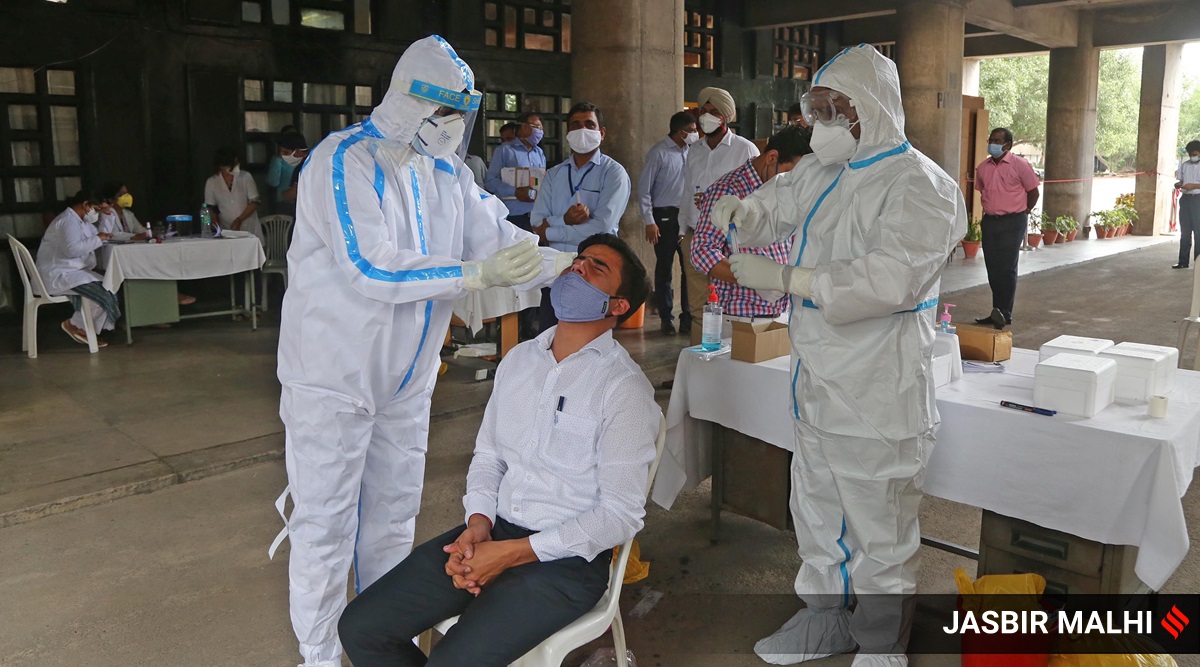 Health teams conduct Covid-19 testing ahead of the state Assembly session in Chandigarh on August 24, 2020. (Express Photo: Jasbir Malhi)
Health teams conduct Covid-19 testing ahead of the state Assembly session in Chandigarh on August 24, 2020. (Express Photo: Jasbir Malhi)At least 28 per cent out of Haryana’s total coronavirus infections till August 27 are people in private jobs or business, while 13 per cent are women homemakers, according to occupation-wise data of the infected people that has been compiled by Haryana government’s Health Department. The state had 59,298 cases till August 27, out of which 7,697 are homemakers, and 16,762 are people in private jobs or business. These two categories comprise majority of people getting infected in the state according to the detailed analysis on the profile of people getting infected carried out across Haryana.
At least nine per cent (5,210) of the total people infected, till August 27, are students. As per Centre’s Unlock 4.0 guidelines, Haryana is set to permit, from September 21, students of Class 9 to 12 to visit the schools, in areas outside the Containment Zones only, on voluntary basis, for taking guidance from their teachers. This will be subject to consent of their parents/guardians.

Further, among the total cases analysed by the Health Department, five per cent (3,099) are government employees — including Army and police, three per cent (1,973) are health staff, two per cent (1,306) are labourers/ farmers, and approximately one per cent each are drivers (242) and vendors (204). A larger chunk, 38 per cent are those who are involved in miscellaneous occupations.
“This miscellaneous category includes around 10-11 per cent such people who do not fall in any specific occupation category like farmers, private job/business etc. Around 20 per cent are such people who did not disclose their occupation. Since it is not a compulsory component of the data being collected for the Covid-positive patients, some people did not disclose it. But, we are still in the process of calling them and collecting relevant information,” a senior Haryana Health Department officer told The Indian Express.
The analysis conducted by Haryana’s Health Department also revealed that at least seven districts are such where the Covid-positive rate is quite high. As on August 27, Faridabad was on top with 10.04 per cent, Panipat with 8.54 per cent, Rewari with 8.46 per cent, Mahendragarh with 6.91 per cent, Gurgaon with 6.88 per cent and Ambala with 6.58 per cent.
However, the Health Department attributes the higher positive rate to higher testing ratio in these districts. For instance, the number of tests per million population on August 27 in Gurgaon was 1,11,336, Faridabad (68,322), Panipat (32,715), Rewari (44,206), Mahendragarh (25,627), and Ambala (47,271).
In order to assess the extent of spread of coronavirus infection in each district, the Health Department is also heavily relying on the GIS mapping. “A positive patient’s location in terms of the area in which he had travelled before testing Covid-positive, the people he met during this time and his workplace is tagged on the map using satellite imagery. It helps us to analyse the Covid-19 active positive cases (ward wise). Comparative maps are analysed on a daily basis to find out if the infection is spreading in a particular ward. Action is immediately taken in such circumstances. For instance, in industrial areas we had been doing intensive rapid antigen testing. Although it may not give us 100 per cent findings, but still at one given time we are able to immediately isolate 20-30 per cent people who turn positive. That saves us lot of time and we are also able to curtail the further spread”, Haryana’s ACS (Health) Rajeev Arora told The Indian Express.
State Health Department, in association with the state police is also using Covid-19 Quarantine Alert System – a technology based platform to find out if a Covid-positive person who is supposed to be in quarantine has changed his location. “We make use of technology to maintain surveillance of such person who is suspected to be changing his location even after testing positive. Whenever we detect a violation on the person’s part, we first give him a warning. If he does not follow the standard protocol of quarantine, then we initiate action. There are several cases where we have initiated prosecution against people who were repeatedly violating the quarantine norms,” another senior officer of Health Department told The Indian Express.
The Health Department is also making use of Itihas – a web-based application developed by IIT Chennai that uses mobile tower locations of Covid-affected persons to track their changing locations. Examining the data collected by using this application, the state Health Department also manages to assess an emerging hotspot where the coronavirus infection is likely to spread in the coming days.
“That helps us in preparing ourselves in advance, launching intensive testing campaign, identifying the containment zones etc”, a senior officer added.